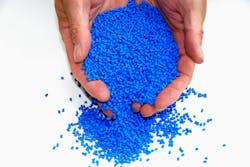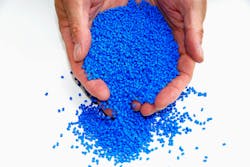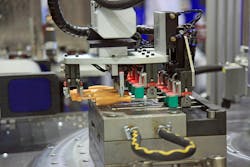How Thermoset and Thermoplastic Composites Improve Structural Performance
When performance matters, thermoset and thermoplastic composites provide durability. Their unique properties make them well-suited for demanding applications, especially where efficiency and environmental considerations are key.
The aerospace, automotive, infrastructure and consumer products sectors have tough standards to meet. Getting the most out of composite systems starts with understanding the underlying resin chemistries and knowing how resin chemistry and functional additives work together.
Thermosets vs. Thermoplastics: Distinct Chemistries, Unique Strengths
Thermoset composites create a rigid, cross-linked structure when the resin is cured by permanent chemical reactions. Epoxy, vinyl ester and polyester are common thermoset resins that produce favorable outcomes such as high thermal resistance, structural integrity and high performance under stress. Once cured, thermosets cannot be reshaped or remelted, which makes them useful for high-temperature and demanding applications.
READ MORE: The Benefits of Thermoplastics vs. Thermosets for Modern Bike Designs
Thermoplastic composites use resins like polyether ether ketone (PEEK), polypropylene (PP) and polyamide (PA). These materials become pliable when heated and solidify again as they cool, which makes them ideal for reshaping and recycling. They are easy to work with and provide excellent shock absorption and chemical stability. The strength and reusability of thermoplastics make them ideal for inventive engineering applications.
Role of Resin Chemistry and Additives
The performance of both thermoset and thermoplastic composites hinges on precise resin formulation; consistency is critical for reliability, repeatability and uniformity of the final product. The following key additives influence resin curing properties and performance during use.
- Curing agents. In thermoset systems, curing agents initiate and control the cross-linking reaction. The agent formulation impacts cure speed, resilience in extreme temperatures and product strength.
- Flame retardants. Both composite types use flame retardants to meet safety standards.
- Halogen-free retardants improve compliance with environmental standards.
- Stabilizers. Outdoor and high-temperature applications benefit from UV and thermal stabilizers, which minimize degradation.
- Tougheners and plasticizers. Thermosets incorporate these additives to improve the flexibility and impact performance; thermoplastics benefit with enhanced processability.
Processing Advantages and Manufacturing Efficiency
Thermoset composites are often processed via hand lay-up, resin transfer molding (RTM) or filament winding. These methods allow for excellent fiber wet-out and the creation of complex, high-strength parts. Because thermosets cure at relatively low pressures, the tooling and equipment costs can be lower.
Thermoplastics, on the other hand, benefit from faster cycle times and compatibility with automated techniques like injection molding and thermoforming. Their ability to be reheated and reshaped reduces waste and supports lean manufacturing principles.
The choice between thermoset and thermoplastic composites depends on how the resin affects the blending process. Variables such as production speed, performance requirements and cost will influence material selection.
Designing for Endurance
Resilience is a key strength of composite materials. They’re built to withstand product fatigue, corrosion and harsh environmental conditions. Thermoset composites, with their tightly linked structures, deliver excellent long-term stability in chemically aggressive or high-temperature settings. Thermoplastics, on the other hand, offer exceptional toughness and absorb impact well, which makes them a strong choice for applications exposed to constant movement or vibration.
Additives play a major role in boosting durability for both types. Stabilizers help guard against UV damage and thermal wear, while flame retardants ensure the materials meet strict safety codes, especially in transportation and building sectors. Because every application is different, engineers can fine-tune each resin system to match its specific environment, giving the end product a longer, safer service life.
Best Practices in Chemical Handling and Packaging
Getting the best performance out of composites starts well before they hit the mold. How the resin is stored and handled can make a big difference in quality and safety. Thermoset resins don’t last forever; they’re sensitive to moisture and temperature, so they need to be kept sealed and in a controlled environment. Thermoplastics, especially in pellet form, also need to stay clean and dry to avoid problems during processing.
READ MORE: Thermoplastic Composites
Some best practices to keep in mind:
- Label and date chemical containers so there’s no guesswork later.
- Use sealed, non-reactive packaging to keep out moisture and prevent oxidation.
- Keep an eye on storage conditions, especially temperature and humidity.
- Follow safety regulations for any flammable or hazardous additives.
- Collaborate with suppliers to maintain quality throughout the supply chain.
How Composites Are Shaping Industry
As composites get smarter, so do industries who use them. Better resin systems allow companies to improve how they design, build and maintain everything from infrastructure to vehicles. To give a few examples:
- Aerospace. Thermoset carbon fiber composites are extensively used in aircraft structures, offering exceptional strength-to-weight ratios. These materials enhance fuel efficiency, reduce emissions, and meet the demanding thermal and mechanical stresses of flight environments.
- Automotive. Polypropylene and polyamide are popular material choices in automotive because they’re tough and easy to shape. The result is lighter vehicles, which boosts fuel economy and resilience during accidents.
- Infrastructure. More engineers are using thermoset composites for civil projects such as bridge decks, rebar and pipelines. Their natural resistance to corrosion and long lifespan make them a smart, cost-effective alternative to traditional steel in tough environments. Thermoplastics also play a role here, supporting modular builds that are fast to install and tough enough to handle everyday impact in off-site construction.
- Cross-industry innovation. When resin systems are precisely formulated, engineers gain the freedom to shape their performance-enhancing qualities like flame resistance, stiffness or flexibility. That customization paves the way for high-performing, lightweight solutions used in everything from energy infrastructure to high-end sports equipment.
The Composite Advantage
Thermoset and thermoplastic composites take different routes, but both lead to stronger, more reliable materials. When engineers fine-tune the chemical blending process by adjusting the resin mix and additives, the result is lighter components, better durability and real-world efficiency. Those who understand how these resins behave in the lab and on the floor can design with more confidence and build with long-term performance in mind.
About the Author
Mike Lange
Vice President of Sales, SolvChem
Mike Lange is vice president of Sales at SolvChem, a large independent chemical distributor. He has 25 years of commercial and executive leadership experience in the distribution industry. Lange is responsible for strategic direction and commercial execution of SolvChem’s account management team.


